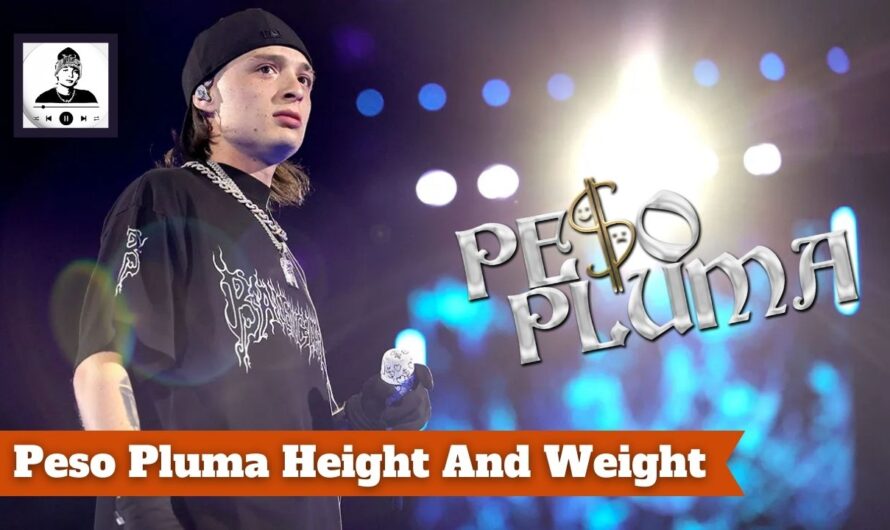Ever wondered about peso pluma height in inches? Well, you’re not alone. Boxing fans around the world are always curious about the physical attributes of fighters, and height plays a crucial role in understanding their competitive advantage. In this article, we’ll dive deep into everything you need to know about peso pluma fighters and their height in inches.
When it comes to boxing, weight classes matter a lot. Peso pluma, or featherweight, is one of the most exciting divisions in the sport. Fighters in this category are known for their speed, agility, and technical prowess. But what about their height? Does it really affect their performance? We’ll explore all these questions and more.
This article is designed to provide you with an in-depth understanding of peso pluma fighters, their height in inches, and how it impacts their game. Whether you’re a die-hard boxing fan or just curious about the sport, you’ll find plenty of valuable insights here. So, let’s get started!
Table of Contents
Introduction to Peso Pluma Division
Average Height and Weight of Peso Pluma Fighters
Biography of Top Peso Pluma Fighters
How Height Impacts Performance
Training Tips for Peso Pluma Fighters
A Historical Perspective on Peso Pluma Boxing
Future Trends in the Peso Pluma Division
Conclusion: The Importance of Height in Boxing
FAQs About Peso Pluma Height in Inches
Introduction to Peso Pluma Division
The peso pluma division, also known as featherweight, is one of the most popular weight classes in boxing. Fighters in this category weigh between 122 and 126 pounds. It’s a division where speed, technique, and precision reign supreme. Over the years, some of the greatest boxers in history have fought in this weight class.
One of the key factors that set peso pluma fighters apart is their height. While weight is strictly regulated, height can vary significantly among fighters in this division. Some are tall and lean, while others are shorter and stockier. Understanding these differences is crucial for both fans and fighters alike.
Let’s break it down. Why does height matter so much in boxing? And how does it specifically impact peso pluma fighters? Stick with us as we explore these questions in detail.
Why Height Matters in Boxing
In boxing, height can be both a blessing and a curse. A taller fighter typically has a longer reach, which allows them to land punches from a distance. This can be a significant advantage in the ring. However, taller fighters may struggle with balance and agility, especially if they’re not properly conditioned.
On the other hand, shorter fighters often have better footwork and are quicker on their feet. They can close the distance quickly and deliver powerful punches. The key is finding the right balance between height, reach, and overall athleticism.
In the peso pluma division, height in inches can make all the difference. A fighter who is just a few inches taller might have a significant advantage over their opponent. But it’s not just about height – it’s about how effectively a fighter uses their physical attributes in the ring.
Peso Pluma Height in Inches
So, what’s the average height of a peso pluma fighter in inches? While there’s no hard and fast rule, most fighters in this division stand between 5 feet 4 inches and 5 feet 8 inches. However, there are exceptions on both ends of the spectrum.
Some of the tallest peso pluma fighters have been known to reach 5 feet 9 inches or even taller. Meanwhile, shorter fighters in the division might stand at just 5 feet 2 inches. It’s this diversity in height that makes the peso pluma division so fascinating to watch.
Let’s take a look at some of the most notable peso pluma fighters and their heights:
- Manny Pacquiao – 5 feet 5.5 inches
- Aaron Pryor – 5 feet 6 inches
- Prince Naseem Hamed – 5 feet 7 inches
- Eder Jofre – 5 feet 6.5 inches
Height Variations Among Peso Pluma Fighters
While the average height in the division is around 5 feet 6 inches, there’s plenty of variation. Some fighters prefer to stay on the shorter side to maximize their speed and agility, while others aim for height to gain a reach advantage. It all depends on the fighter’s style and strategy.
Interestingly, height isn’t the only factor that contributes to a fighter’s success in the ring. Factors like weight distribution, muscle mass, and overall conditioning also play a significant role. But height in inches remains a key metric for evaluating a fighter’s potential.
Average Height and Weight of Peso Pluma Fighters
When discussing peso pluma fighters, it’s important to consider both height and weight. As mentioned earlier, fighters in this division typically weigh between 122 and 126 pounds. But what about their height?
On average, peso pluma fighters stand at around 5 feet 6 inches. However, this number can vary depending on the fighter’s nationality, training regimen, and genetic predisposition. For example, fighters from certain regions may naturally be taller or shorter than others.
Here’s a breakdown of the average stats for peso pluma fighters:
- Height: 5 feet 4 inches to 5 feet 8 inches
- Weight: 122 to 126 pounds
- Reach: 68 to 72 inches
Does Height Really Matter?
While height is an important factor, it’s not the only thing that determines a fighter’s success. Many shorter fighters have managed to dominate taller opponents by using their speed and agility to their advantage. That said, having a few extra inches can certainly give a fighter an edge in the ring.
Ultimately, it’s about how effectively a fighter uses their physical attributes. Whether they’re tall or short, a great fighter knows how to adapt to their opponent’s style and exploit their weaknesses.
Biography of Top Peso Pluma Fighters
Let’s take a closer look at some of the most legendary peso pluma fighters in history. Here’s a brief biography of each fighter, along with their height in inches:
| Name | Height (in inches) | Weight Class | Notable Achievements |
|---|---|---|---|
| Manny Pacquiao | 65.5 | Peso Pluma | 12-time world champion across 8 weight divisions |
| Aaron Pryor | 66 | Peso Pluma | Two-time world champion |
| Prince Naseem Hamed | 67 | Peso Pluma | IBF Featherweight Champion |
| Eder Jofre | 67.5 | Peso Pluma | Regarded as one of the greatest featherweights of all time |
How Height Impacts Performance
Height can have a significant impact on a fighter’s performance in the ring. A taller fighter with a longer reach can keep their opponent at bay, landing jabs and combinations from a distance. This can be particularly effective against shorter fighters who struggle to close the gap.
However, taller fighters may face challenges when it comes to balance and agility. If they’re not properly conditioned, they may find themselves off-balance during exchanges. This is where shorter fighters can gain an advantage by using their quick footwork and explosive power.
Ultimately, it’s about finding the right balance between height, reach, and overall athleticism. A fighter who can effectively use their physical attributes in combination with solid technique and strategy is more likely to succeed in the ring.
Training for Height Advantage
For taller fighters, training for balance and agility is crucial. Incorporating exercises like plyometrics and core strengthening can help improve stability and coordination. Meanwhile, shorter fighters should focus on building explosive power and speed to close the distance quickly.
Regardless of height, all fighters need to prioritize conditioning and technique. A well-rounded training regimen that includes strength, endurance, and skill development is essential for success in the peso pluma division.
Training Tips for Peso Pluma Fighters
Here are some training tips specifically tailored for peso pluma fighters:
- Focus on cardiovascular endurance to last all 12 rounds.
- Incorporate strength training to build muscle without adding unnecessary weight.
- Practice footwork drills to improve agility and balance.
- Work on defensive techniques to minimize damage from opponents.
- Develop a strong mental game to stay focused under pressure.
Remember, training isn’t just about physical preparation – it’s also about mental toughness. A fighter who can stay calm and composed in the heat of battle is more likely to succeed in the ring.
A Historical Perspective on Peso Pluma Boxing
The peso pluma division has a rich history that dates back to the early days of boxing. Some of the greatest fighters in history have competed in this weight class, leaving a lasting legacy in the sport. From Eder Jofre to Manny Pacquiao, the division has produced countless legends who have inspired generations of fans.
One of the reasons the peso pluma division is so popular is its emphasis on skill and technique. Fighters in this weight class are known for their precision and ability to outthink their opponents. It’s a division where brains often triumph over brawn, making it a favorite among boxing purists.
Key Moments in Peso Pluma History
Here are some of the most memorable moments in peso pluma boxing history:
- Eder Jofre’s dominance in the 1960s, earning him the nickname "The Brazilian Marvel."
- Manny Pacquiao’s rise to fame in the early 2000s, cementing his status as one of the greatest boxers of all time.
- Prince Naseem Hamed’s flamboyant style and knockout power, making him a fan favorite in the 1990s.
Future Trends in the Peso Pluma Division
As boxing continues to evolve, the peso pluma division is likely to see some exciting changes in the coming years. Advances in training techniques and nutrition are helping fighters push the boundaries of what’s possible in the ring. We’re also seeing more international talent emerging, bringing fresh perspectives and styles to the division.
One trend to watch is the increasing emphasis on cross-training and interdisciplinary approaches. Fighters are incorporating elements from other combat sports, such as martial arts and wrestling, to enhance their skills and adaptability. This could lead to even more dynamic and exciting matchups in the future.
Conclusion: The Importance of Height in Boxing
In conclusion, height plays a crucial role in the peso pluma division, but it’s not the only factor that determines a fighter’s success. While having a few extra inches can provide a reach advantage, it’s how effectively a fighter uses their physical attributes that truly matters.
Whether you’re a fan of boxing or an aspiring fighter, understanding the nuances of the peso pluma division can enhance your appreciation for the sport. From the legendary fighters of the past to the rising stars of today, this weight class continues to captivate audiences around the world.
So, what’s next? If you enjoyed this article, feel free to leave a comment or share it with your friends. And don’t forget to check out our other articles for more insights into the world of boxing.
FAQs About Peso Pluma Height in Inches
Q:


